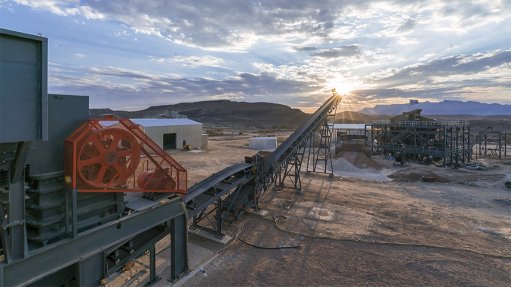
AfriTin's Uis mine, in Namibia
Aim-listed AfriTin Mining says it is excited about the opportunity to diversity and consolidate its tech-metal exposure, after receiving positive preliminary results from lithium beneficiation test work.
The company will soon launch an 8 000 m lithium and tantalum exploration drilling programme to increase the confidence levels of lithium and tantalum by-product potential at its Uis tin mine, in Namibia.
“The presence of significant tantalum and lithium oxide mineralisation within the V1/V2 orebody creates an opportunity for the development of additional revenue streams to our tin concentrate product.
“Therefore, we are advancing a metallurgical test work programme aimed at developing the process flow to efficiently produce both tantalum and lithium oxide by-products,” AfriTin states.
AfriTin started producing tin at its 85%-owned Uis mine in 2020 and plans to ramp up to a capacity of 10 000 t/y in a Phase 2 expansion project.
Meanwhile, lithium oxide at Uis occurs primarily as the mineral petalite in the ore, which is treated by the current processing facility. The company aims to produce a low-iron petalite concentrate containing a minimum of 4% lithium oxide and a maximum of 0.05% iron oxide.
It is anticipated that the process flow design of a petalite concentration circuit will involve a combination of density separation, flotation and magnetic separation methods.
The current phase of AfriTin’s lithium oxide test work programme will investigate density separation methods to concentrate petalite. Bulk samples were acquired from the active mining area and transported to test work facilities in South Africa.
Heavy liquid separation (HLS) test work and pilot dense medium separation (DMS) test work are being conducted concurrently.
Preliminary results from HLS tests indicate an upgrade factor for lithium oxide of four to five times, which is in line with the company’s projections for DMS pre-concentration.
The HLS and DMS test work will be followed by characterisation of concentrate samples, which will inform the second phase of test work.
AfriTin explains that tantalum at the Uis mine occurs primarily within columbite group minerals, which have a similar density to the tin-bearing mineral cassiterite and is currently recovered as part of the tin concentrate.
At present, the company does not receive a credit for the contained tantalum within the tin concentrate. Therefore, the aim is to separate the tantalum-bearing minerals from the tin concentrate and create a by-product.
While optimisation test work on tantalum continues, the company will proceed with the process flow design for a pilot tantalum concentrate production facility at Uis, with implementation planned for the fourth quarter of this year.
In tandem to the metallurgical test work and process development, AfriTin has started a larger exploration focus over its licence areas. The immediate priority is an infill exploration drilling programme over the V1/V2 orebody aimed at increasing the geological confidence of the existing mineral resource estimate for tantalum and lithium oxide.
The programme aims to improve the classification of these minerals from inferred to indicated and measured categories, for that portion of the orebody extending to a depth of about 150 m.
This will provide increased confidence in mineral concentration and production estimation modelling and may lead to the existing ore reserve estimate for tin being updated for tantalum and lithium oxide.